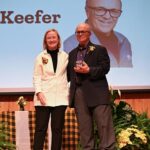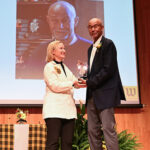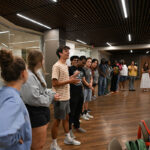
Chemistry Lab students learn art of conservation

Exploring the chemistry in art led some students at The College of Wooster this spring to create pigments, see up close the properties of different paint binders, and study how acidity changes a dye.
The general chemistry course, taught for the first time in spring 2023 by Sarah Sobeck, chemistry professor and associate dean for experiential learning, included a nod to the interdisciplinary study of conservation through scientific inquiry through chemistry. Also known as conservation science, Sobeck incorporated the topic into the course especially for students who aren’t likely to be chemistry majors but whose area of study could overlap with chemistry. Some students enrolled in the spring class, for example, were majoring in subjects as diverse as art history, archaeology, and earth sciences, and some were in the museum and archival studies pathway, which explores the traditions of collection, curation, research, display, and preservation.
Katie Love ’24 is an art history major who took the course because it relates to her planned career in art conservation. Initially, she hesitated to pursue art conservation because of the chemistry component. “Dr. Sobeck used art and art conservation to supplement the chemistry material which made the material more understandable and interesting. It constantly reminds me why I want to go into art conservation, even when chemistry gets challenging,” Love said.
The idea to combine chemistry and art for the course stemmed from Sobeck’s research in cultural heritage, realized from opportunities during her time at Wooster. Sobeck is a classically trained chemist, and most of her work has focused on photochemistry. She had an “aha!” moment during a session on photochemistry for cultural heritage at a European conference. After the meeting, she did sabbatical research focused on cultural heritage at Yale University’s Institute for the Preservation of Cultural Heritage and the Indianapolis Museum of Art, and participated in conferences that pertained to conservation science. Integrating cultural heritage with chemistry allowed Sobeck to connect her longtime interest in art with the work in her professional life.
She started the course to bring that interdisciplinary focus into the classroom and lab to engage students interested in careers in museums and art galleries, where a foundation in chemistry could be beneficial. Because chemistry is the basis of paints, papers, and materials in art, as well as invaluable for the preservation and study of the remnants of cultural heritage, experiments in the lab and regular reflections on the work offered an ideal formula for students to explore those connections. Students considering curation, conservation, or preservation work, for instance, benefit from thinking about the materials they would be working with in museums and galleries. “Nowadays, more museums have access to scientific equipment to test what is there, but they also must be thinking about how to store and exhibit objects so that they aren’t damaged,” Sobeck said.
Students prepared for conversations about preservation by learning to test colors, identify materials, and look at the chemical nature of paints. The lab activities helped them better understand the significance of analyzing and identifying materials in museum work. “These types of opportunities help students see how their lab work connects to their life beyond the class. They learn to bring together these different viewpoints and weave them into a fulfilling career for the longer run,” Sobeck said.
The CHEM 111 course appealed to Byron Schump ’25, who is interested in the field of art conservation. “A surprisingly large part of that is chemistry based in addition to art history,” he said. “This class let me access that topic without taking a class with so many premed students.”
Wooster’s introduction to art and artifact collection, curation, and preservation careers via the experiential chemistry lab is distinctive. “Conservation programs are typically master’s level programs,” Sobeck said. “Now we’re starting to see at the undergraduate level more opportunities such as museum studies, and we’re starting to bring the professional conversations or career conversations to the undergraduate level to help students explore more from the get-go, what they might do longer term.”
Beyond the interdisciplinary nature of chemistry and art, the introductory chemistry course also included a lab experience, said Rebecca Partee ’24, a chemistry major from Pittsburgh, Pennsylvania, who helped Sobeck develop the course. Partee worked with chemistry majors Megan Zins ’22 and David Evans ’24 as Sobeck’s summer research assistants, where, in addition to carrying out research, they found art-related lab activities that were instrumental for the experiential learning component.
“First-semester chemistry students at Wooster do not generally have a lab component to their course. The lab makes this general chemistry course different than a traditional class and makes it a better fit for students who may not want to continue past the first class but still want some experience with chemistry and chemistry labs,” Partee explained. The lab activities were heavily tailored to students interested in art and art conservation and tied closely to what was learned in class, Partee said. “It was different from a general chem lab because I don’t think you’d get to make your own paint.”
In addition to the lab activities and reflections on their experiences, students also heard from professionals in the field including Greg Smith, senior conservation scientist at the Indianapolis Museum of Art; Marianne Wardle, College of Wooster Art Museum director and curator; and Denise Monbarren, Wooster Special Collections librarian. Each talked about their roles in curation, conservation, and preservation and the importance of collaborating with others throughout the process.
By addressing different areas of interest, students began to appreciate how people from various specialties and with unique skill sets collaborate, Sobeck explained. “Students reflect on their experiences to see the connections between their coursework and their broader goals. Experiential-learning designated courses involve putting the best practices of our professional society into play,” she said.
Featured image: Professor Sobeck, pictured here with Aidan Burd ’26, engaged the class in regular reflections connecting their lab work to preservation and the study of cultural heritage.
This feature first appeared in the summer 2023 edition of Wooster magazine.
Posted in Magazine on June 21, 2023.
Related Posts
Related Areas of Study
Museum Studies
The Museum Studies minor requires six courses, with one required course and the remaining to be selected from experiential and theory courses. Alongside MUST […]
MinorArt - Studio Art
Studio space, small classes with talented instructors, and the strong foundation that comes with a liberal arts education.
Major MinorMuseum & Archival Studies
Explore the diverse traditions of collection, curation, research, display, and preservation and plan your career
PathwayChemistry
Access to labs, research opportunities, and small classes give chemistry majors lots of options after graduation.
Major MinorArt - Art History
Explore the cultural and historic significance of art and artists while building research and analytical skills.
Major Minor

